Tag: DuCard Vineyards
Tim Mondavi and Cabernet Franc
We’ve been pretty sure for a while now that Cabernet Franc was a good bet for our small vineyard. It’s a wonderful grape for blending, often used to soften the harsh tannins in its close cousin, Cabernet Sauvignon, and it is lovely on its own as a varietal. And we’ve tasted it at enough wineries in enough different parts of the state to believe that it’s well suited to the growing conditions found in Virginia.
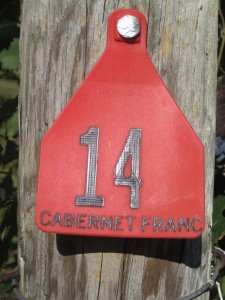 It is (usually) the dominant grape in Cheval Blanc, one of the great wines of Bordeaux. It is not a first growth, since Saint-Emilion was not included in the 1855 classification, but in the 1955 Saint-Emilion classification, it was one of two ones to be ranked as a "Premiers Grands Crus Classés A." And, of course, the 1961 Cheval Blanc was the wine that Miles had hidden away for a special occasion in Sideways. (He drank it from a paper cup at the end while at a McDonalds, since his love interest had told him that — and I'm paraphrasing from memory — any time you drink a Cheval Blanc, it's a special occasion.)
It is (usually) the dominant grape in Cheval Blanc, one of the great wines of Bordeaux. It is not a first growth, since Saint-Emilion was not included in the 1855 classification, but in the 1955 Saint-Emilion classification, it was one of two ones to be ranked as a "Premiers Grands Crus Classés A." And, of course, the 1961 Cheval Blanc was the wine that Miles had hidden away for a special occasion in Sideways. (He drank it from a paper cup at the end while at a McDonalds, since his love interest had told him that — and I'm paraphrasing from memory — any time you drink a Cheval Blanc, it's a special occasion.)
For those of you willing to spend upwards of $1,000 a bottle (and more) on a Cheval Blanc, I have no doubt you will feel the money well spent. But if you do, then don’t hesitate to invite me to share it with you. I’ve never tasted Cheval Blanc, but I’ve certainly lusted over the thought.
However, if you are among the 99 – make that the 99.9 – who can’t afford Cheval Blanc, you should think about a Virginia wine that is either entirely Cab Franc or included as the dominant grape in a blend. Almost every winery in Virginia seems to have a Cab Franc in its tasting room, and many of them are splendid.
But while we’re sold on Cab Franc, it’s always nice to hear that others feel the same way. In the Nov. 15 issue of The Wine Spectator, a lengthy article on Tim Mondavi includes a sidebar (The Francophile in Continuum,) that highlights this great winemaker's love for Cab Franc.
"The wines that had the highest percentage of Cabernet Franc were the wines I loved the most," says Tim. "When I would be looking at the wines in barrel, I found there was a higher perfume [in Franc] that was very different from Cabernet Sauvignon. It also adds viscosity and suppleness you can't find with Cabernet Sauvignon or Merlot."
Franc does need to be ripe, the Wine Spectator adds. “Otherwise it can be herbal, stalky and coarse.”
That’s precisely the problem that some identify in Virgina reds – vegetal flavors, usually produced by a compound known as methoxypyrazine that comes from grapes that are not quite ripe. The risk is especially pronounced in areas with short growing seasons or in years when rain or other conditions force an early harvest. Done right, Cab Franc can be wonderful, in Virginia wines as well as in Mondavi’s Continuum.
In another four years, after the vines have matured, the grapes have been picked and fermented, and the wine has been in the bottle for a suitable period of time, I’ll be able to tell you how well it worked out.
Bringing in the Grapes — Part V
Readers of ProjectSunlight have noted a recurring theme over the past month. The weather, at least insofar as vineyard mangers in Virginia are concerned, really sucked this year.
It may be small comfort to the Commonwealth’s vignerons, but the weather has generally sucked worldwide. Jancis Robinson, in her Financial Times column last weekend, detailed the carnage in California and Europe, and even in the Southern Hemisphere, where the growing season is reversed.
“If Europe’s vintners have found 2011 much more trying than any other recent vintage, six months earlier, while picking their 2011s, the Australians experienced the vintage from hell,” she wrote. “Harvest time in the supposedly sunny wine state of South Australia was sodden. Winemakers have had to work extremely hard in some areas to fashion drinkable wine out of bloated, rotten grapes.”
And it goes beyond Australia. “The vintage in New Zealand was bloated too, thanks to frenzied recent planting of vines there, fuelled by a belief that the world is in love with Kiwi Sauvignon Blanc,” she added. “Argentine growers were also afflicted by rain at harvest time in 2011, as well as the usual hail, and unusually late frost in November last year.”
So, weather-related problems span the globe. As I’ve noted before, that’s the way it is with agriculture. You really have no control over the weather, although you can compensate to some extent – to a great extent in normal years, less so in years like 2011 – with a disciplined spraying program.
And winemakers can exert some magic of their own once the grapes come in. This year will be difficult for sure, and none of the winemakers I’ve spoken to have any illusions about the challenges ahead of them. This vintage will definitely separate the men from the boys, so to speak, and show, as Ms. Robinson said, “who exactly are those master craftsmen.”
Bringing in the Grapes – IV
The harvest is so full of unknowns. You never know exactly when the grapes will ripen – when the pH, Brix, tannins, flavor, and so many other variables will all be perfect – and so vineyard managers study the vines each day as
the growing season nears the end, squeezing juice from a random selection of grapes onto the refractometer, checking the seeds, examining the skins, measuring the pH, tasting the juice, and no doubt thinking, “Why me, God – why do You make me suffer each fall?”
But of course, that’s what makes viticulture the wonder that it is. Each season is different. So much work goes into growing the grapes and then so much judgment and so much hope goes into the decision about when to harvest.
Without a doubt, this has been the most difficult growing season in memory in Virginia. It’s hard enough to fathom out the date when the grapes will achieve the perfect balance of sugar and acid, without the additional complication that comes from weather. Consider this: If the grapes will be perfect on Wednesday, but it rains on Tuesday, then you probably would have been much better off picking on Monday, when they were a few days shy of perfection.
And here’s another twist: if it rains on Sunday and Monday, and the grapes swell from the
precipitation, you might think it wise to wait until Thursday or Friday to give them a chance to recover. If the sun comes out and stays out, you will think yourself a genius. But if it rains again, you may curse your stupidity.
Rain causes so much trouble at harvest. The grapes swell and split, bees attack, and the vineyard is ravaged by sour rot and botrytis. Botrytis is a problem, but it can be dealt with in the winery. Sour rot is different. You can see it and smell it, a sour vinegary odor that is apparent in the juice that breaks out of the berries and covers your hands. It’s best to let those grapes fall to the ground.
Every year brings something new, and this year when we arrived at DuCard Vineyards to pick Cab Franc, it was unseasonably cold. The thermometer read 47 degrees when we woke, and didn’t get above 50 until 8 a.m. At that temperature, it would be hard to get the grapes to begin fermenting, so we waited until 10 a.m., after the morning had warmed up just a bit, to start picking.
And what a glorious day it turned into!
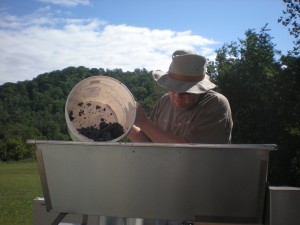
Here's the difference between a good harvest and a bad one -- how you pour the grapes into the crusher. 🙂
As Scott Elliff, owner of DuCard Vineyards said on a recent Saturday, this is what we’ve been working toward all year! This is the harvest – this is the fun part!
He was right. It was like a celebration. We (the Vineyard Goddess and me) spent that day at DuCard picking Cab Franc grapes with a dozen of our friends from viticultural classes at Piedmont Virginia Community College. And while it was work, it was also joyous fun. Continue Reading–>
Outsmarting Birds and other Vineyard Predators
The grapes at DuCard Vineyards are starting to ripen nicely, which means that pretty much every creature that walks, flies or crawls is out to feast on them.
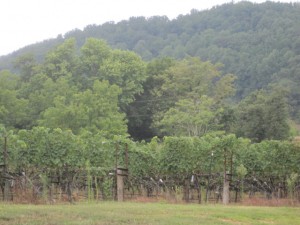
DuCard Vineyards in mid-August. The Cab Franc grapes are looking beautiful. Should be another great vintage for DuCard
There’s an old saying that goes something like this: when the deer begin eating the grapes, the Brix (a measure of the sugar level) is 20, when the birds begin feeding, it’s 22, and when the bees go after grapes, it’s time to harvest. (If anyone has a more accurate take on that little bit of country wisdom, please post a comment!)
That aphorism probably ascribes a level of precision to nature that can’t be verified with scientific instruments, but it does give you an idea of what the grape farmer is up against. After a growing season in which the vines are threatened by any one of a dozen pests or diseases, not to mention the vagaries of weather, Mother Nature presents a whole new set of challenges just as the grapes are reaching perfection.
Saturday’s vineyard management class at DuCard focused on a number of these problems, and some of the tried and true solutions that have been used by viticulturists for years. Some are high tech, like the box that transmits sounds of birds in distress throughout the vineyard, and others are decidedly low-tech: balloons and CDs hanging from trellises in spots where they’ll catch a bit of sunlight. All three seem to work pretty well.
Birds apparently have some early warning systems. They understand the vineyard is supposed to look a certain way, and when they see something out of the ordinary, they look for safer pastures, so to speak. The CDs catch a glint of sunlight, and are visible to the birds as they approach, sending off the signal
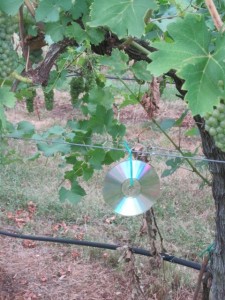
Any old song will do: Not sure if it matters which CDs we hang from the vines, they all seem to scare the birds.
that something is not quite right here, so move on, and be quick about it. The balloons accomplish the same thing. In other vineyards, I’ve seen foil streamers flying in the breeze, which has the same effect.
And the deer will be coming soon as well. DuCard is located in the midst of open country, some of the most beautiful country you’ll ever see, and so it’s home to more deer than any of us can count. The electric fence is going up this week, and between the fence, the balloons and the CDs, Scott thinks he has “about a 95 percent solution,” which I think is a nice compromise with nature.
While walking through the vineyard Saturday, I tasted a few Cab Franc and Viognier grapes, and was impressed by the sweetness. We’re getting toward the end of the period of veraison, the time in which the berries stop growing in size and begin ripening, turning color in the process. The Cab Franc gapes, for example, were about 80 percent there (by my own seat-of-the-pants measurement), with most of the grapes blue-black in color, and only a few still greenish. They’re looking magnificent, and the growing sugar level was evident on my tongue when I tasted the grapes.
As we move toward harvest, the sugar will continue to increase and acidity will drop. The seeds inside the grape will turn color from their current green to more of a brown, and will lose their bitterness. Soon, Scott Elliff, DuCard’s owner, and Julien Durantie, his vineyard manager, will begin testing the grapes regularly, taking advantage of both technology (checking the Brix with a refractometer), and the knowledge that comes from years of working in vineyards (looking at the seeds, chewing the skin to get an idea of the tannins, etc.)
The day of the harvest can’t be predicted this far in advance, and of course each of the four varieties of grapes Scott grows will ripen at different times. But at some point for each, everything will come together, and Scott will make the judgment that it’s time to get the grapes off the vine and onto the crush pad.
And then we can start dreaming about the wine.
The Agony of Dropping Fruit
This is only a guess, albeit a somewhat educated guess, but I suspect every vineyard worker has the same uneasy, guilty feeling the first time he drops fruit from a vine.
By dropping fruit, I mean walking through the vineyard, from one vine to the next, and cutting off perfectly good clusters of grapes and letting them fall to the ground. It seems wasteful, and when you see a cluster of nearly perfect grapes lying on the ground next to your feet, you feel like a butcher. But you have to remain focused and keep your eye on the prize.
“Think about the wine,” said Julien Durantie, the vineyard manager at DuCard Vineyards. Ah, yes, the wine. Don’t worry about the grapes on the ground that will soon rot and return to the soil to nurture future crops. Think ahead a year or more to the wine that will be made from the fruit that remains.
The idea behind dropping fruit is simple: the vine has only so much energy, and by reducing the number of clusters, you end up with a more concentrated juice and much better, much more intense wine. In a sense, this is a continuation of the process we’ve been engaged in throughout the growing season. Early on, we thinned out the shoots, leaving behind a smaller number of shoots that we hoped would produce high-quality grapes. As we moved through the season, pulling leaves to open up the canopy, we continued to remove suckers, laterals, and extra shoots that would deprive the vine of its vigor.
Removing suckers and thinning shoots was one thing. Clipping off beautiful clusters of berries that were turning into wine grapes, was much harder. I tried to keep my mind focused on the wine.
As was the case in many classes before, I found myself nearly paralyzed at the start, not quite remembering what I had been told, and staring at the vine, afraid to make the first cut. And so, I spent time separating out vines that had become tangled, pulling some laterals (which look like a small, separate leaf system), and considering whether to cut this clump or the next one. And finally, as always, I called Scott Eliff, the vineyard’s owner, or Julien, and begged for help.
We were working just at the onset of veraison, the time in which the berries change color. Here and there, we spotted a few cab franc grapes turning purple, but the vines we actually worked on were Viognier, Virginia’s signature white grape. (Actually, while the Virginia Wine Board has declared Viognier to be the Commonwealth’s Signature Grape, I prefer to think of it as the signature white. Cab Franc and Petit Verdot are my choices for reds.
In any event, a little bit of my heart lay on the ground with each cluster of grapes. And I was only the hired (well, volunteer) help. I can’t imagine how agonizing it is for the owner of the vineyard to drop fruit, knowing he or she is reducing the vineyard’s yield significantly with each clip of the pruning shears.
Fortunately, this is one kind of heartache that can be cured by opening and tasting a bottle of wine that has benefitted from the “Green Harvest” of dropping fruit. Wine is often said to be made in the vineyard, and the best is made by vineyards like DuCard that are willing to sacrifice quantity for quality.
Vineyard Diseases and How to Cure Them
It’s scary to think about how many predators are out there waiting to attack the average vineyard. Birds, bees, foxes, rabbits, deer – Even Bambi can’t be trusted! – and a host of insects, from the potato leafhopper to the Japanese Beetle, want nothing more than to devour the vines, from their leaves on down to the grapes themselves. And that isn’t counting the fungi.
Last weekend at Monticello, Gabriele Rausse taught a class on vineyard diseases that was as wonderful (Gabriele and Monticello) as it was depressing (birds, bees, deer – you get it). The predatory Bambis of the world can be controlled fairly easily with fences. Birds, which begin taking a serious look at the vines after the sugar level rises almost to the point where it is time to harvest, can be scared away with foil streamers that are hung at intervals so that they fly in the breeze.
But fungi are a different story. They require lots of attention, and no small amount of chemicals. Unlike California’s wine valleys, where vines grow in dry heat with cool nights and little rain, Virginia vineyards are subject to heat, humidity and lots of rain. (Especially this year.) All of which provides a good, but hopefully not perfect, environment for a variety of fungal diseases to take root, so to speak. Black Rot, Downy Mildew, Powdery Mildew, Botrytis (and not the good kind of Botrytis, the “noble rot” responsible for Sauternes) and many other diseases just lie in wait for the conditions that enable them to ruin a vineyard.
So, that means spraying. Not just once or twice, but routinely, weekly and especially after three-quarters of an inch or more of rain. We’d love to go organic and dispense with the spraying, but it’s not possible in Virginia, at least not with vines. I don’t know if other fruits and vegetables can be grown in Virginia without spraying, but I’m inclined to think you can’t. Certainly, Virginia Tech’s Cooperative Extension service web site has tons of information about spraying programs for fruit and vegetables, which implies that fungicides are needed. But whatever the case for other types of fruit, wine grapevines require spraying.
That’s also true in other environs. Gabriele said they had to spray in his native Italy (the Veneto region), for example. So, it’s not a crime to spray. But it does make for a lot of work and expense, one of the reasons, in fact, that Virginia wine is so expensive.
And by the way, if you're interested in this subject, the best source of information availale, at least for Virginia viticulturists — and probably for grape farmers everywhere — is Mizuho Nita's blog. It's a must-read for anyone interested in growing wine grapes in Virginia.
Spraying is a discipline, and it's one of those things you have to do when it's needed, whenever it's needed, with no exceptions. Hard work, for sure. But I think it's worth it, and that the end result of all that pest management will be wine that is truly memorable.
Canopy Management, Part II
Here’s some pictures from the weekend class at DuCard Vineyard, thanks to classmate Margaret Frazier, who I have no doubt will one day soon be producing very high quality Virginia wines.
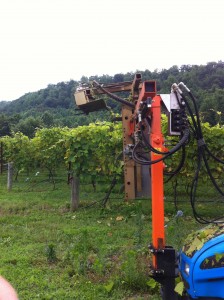
This is the hedger used to trim the tops of the vines in the lyre trellis. It's a bit hard to tell, but the arm of the hedger has whirling blades on both sides, which cuts one arm of the vines.
Canopy Management (And Other People’s Vines)
There's something quite liberating about working on someone else's vines.
Through a class at Piedmont Virginia Community College, we've worked on vines at DuCard Vineyeards now on five separate occasions, starting with dormant winter pruning in late winter and moving on through various stages of the vine's annual growth. On each occassion, I started off, as did many of my classmates, staring at a vine, certain that I was about to ruin it, if not forever, than surely for the season, perhaps costing DuCard a small but meaningful share of its harvest.
Most often, I wanted for DuCard's ever-patient owner, Scot Elliff, or his equally patient vineyard manager, Julien Durantie, to show me just one more time how to do whatever it was that we were expected to do that day. At some point, I would begin working on my own, tentatively at first, but with increasing confidence until at some point, I thought myself almost ready to work without supervision. Continue Reading–>
Goodbye to Grow Tubes Forever!
Apparently there’s no agreed-upon rule book for viticulture.
When we planted Cab Franc vines on our Nelson County property, we followed the advice offered at a class on that very subject at the Piedmont Virginia Community College (great curriculum –the best available in Virginia today), and covered them with grow tubes. We
did the same for the two Mammolo Tuscano vines which we had received as a gift from Gabriele Rausse, one of the founding fathers of the Virginia wine industry and the instructor for a class on grafting.
At another class over the weekend, we were told, in no uncertain terms, to take them off. Sigh.
After doing a lot of overnight research, we decided that the grow tubes – ours are the so-called “Blue X,” which consist of a blue plastic insert and a soft-skin translucent blue sleeve – had to go. But it was kind of a close call.
A lot of the research we looked at suggested that while grow tubes provide a hot-house environment that jump starts the growth of the vines in their early months, they also prevent the vines from achieving their potential. The focus of the first two years is developing a strong trunk and root system. As Julien, the vineyard manager at DuCard Vineyards, told me, you must be willing to do the work, and to do it when it needs to be done. And you must be willing to be patient. The tubes, he added, rushed the process and created a hot-house that could cook the vines to death in the 90-plus degree weather we’ve been having.
My wife, the Vineyard Goddess (and future Vineyard Manager), took Julien’s words to heart and found a good deal of evidence to support the anti-grow tube proposition. Continue Reading–>

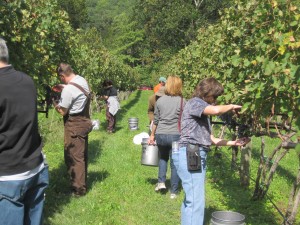
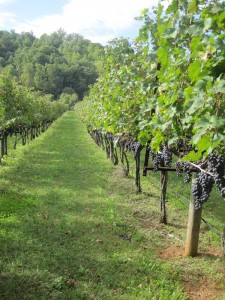
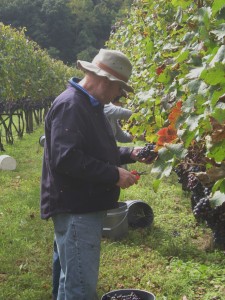
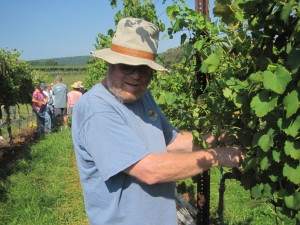
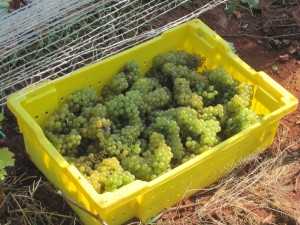
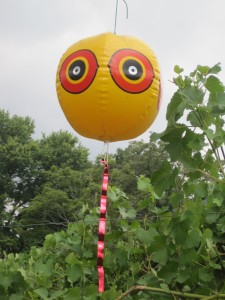
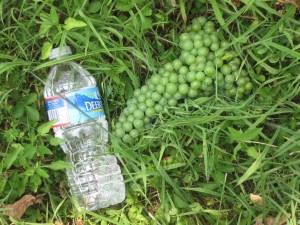
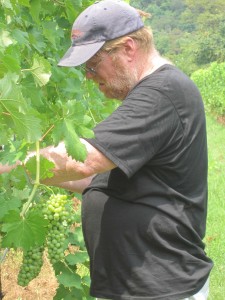
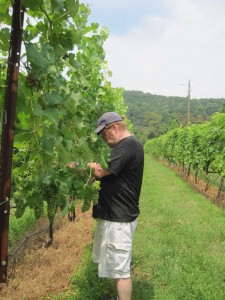
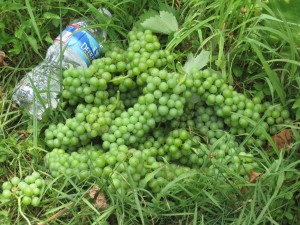
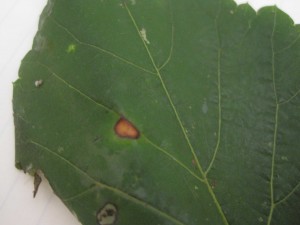
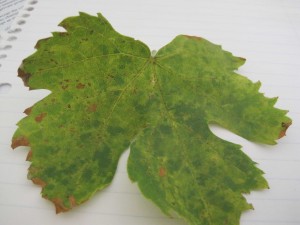
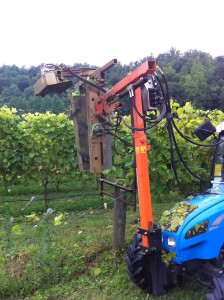
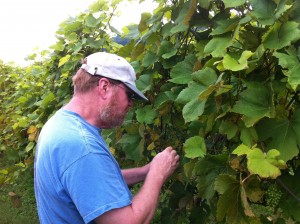
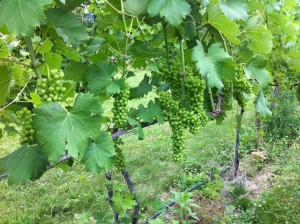
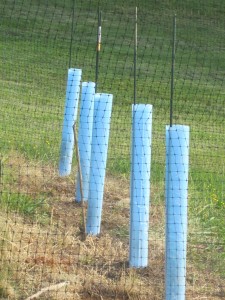


Recent Comments